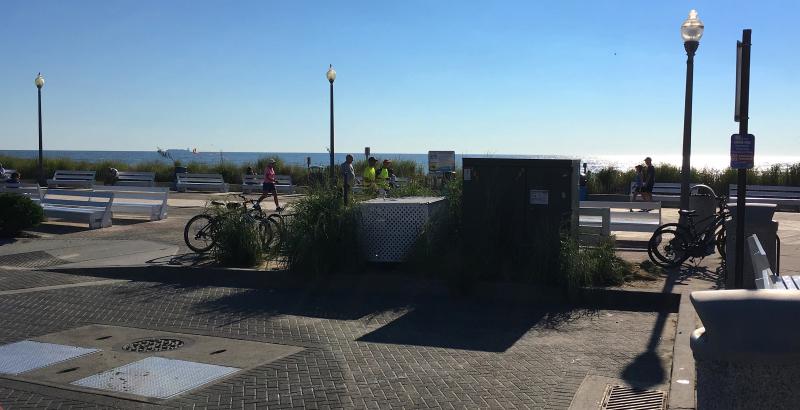Rehoboth assessing city stormwater system

Rehoboth’s incoming public works director says the city’s stormwater system is a hodgepodge of measures, and he intends to find out which ones work.
Public Works Director Kevin Williams said a number of different management systems are in place, such as sand filters on Wilmington Avenue, stormceptors in the area of Silver Lake and a pump system on Rehoboth Avenue. The pump system, Williams reported to the city commissioners in July, is not working. He said that resulted in high levels of pollutants flowing into the ocean after a large storm in late spring.
Williams said he plans to begin work this fall analyzing the city’s stormwater system to determine the best course forward.
“We are assessing the viability of this structure and how it is integrated into the overall stormwater program. We’re also looking into potential for new or different pump technology to determine if that would improve performance,” Williams said.
Former Mayor Sam Cooper says the pumping system that failed was intended to pump out runoff during non-rain events and was never intended to handle large rainstorms. He said aside from the pumps, the system is gravity flow, meaning that when it rains, gravity moves the water through a 36-inch pipe and out to the ocean.
Williams said the system is designed to take the initial flow of street oils, grease and debris, and divert it to the wastewater treatment plant. He said when rain begins, the initial flow enters the vault and causes the water level to rise. A float triggers the pump to turn on and divert the flow to the sewer system. When the water level goes down, a float triggers the pump to turn off and the flow then moves by gravity to the stormwater outfall system.
Williams told the city commissioners July 9 that he was told by city workers the system hasn’t worked for up to two years. Instead of pumping that water away, it remains in the vault area, becoming a breeding area for contaminants. During a big storm, the vault fills and flushes into the ocean, Williams said.
Williams said the city has undertaken an assessment of the vault on Rehoboth Avenue and invested $4,000 to ensure the pumps are operating correctly. The vault and the sand filter on Wilmington Avenue have now been cleaned, and the Rehoboth Avenue pump will be cleaned and inspected on a 60-day cycle. Previously, Williams said, the pump on Rehoboth Avenue was inspected annually, usually in the spring.
The vault on Rehoboth Avenue is an underground, concrete vault that is about 10 feet wide and 10 to 12 feet deep. The pumping system, installed in 2001, is located within the vault.
As part of Rehoboth’s approval for its ocean outfall project, DNREC asked the city to study its stormwater outfall system. The city hired outfall contractor GHD, and the company delivered a final report earlier this summer. Williams said the report discusses stormwater structures, including the vault; GHD reported in May the pump was not working.
Cooper said in the 1960s, the city had a pumping station installed near the Rehoboth library as a response to flooding problems at what is now the Martin’s Lawn parking lot. The city’s stormwater outfall pipes were redone 20 years ago, with the vault and pumping system installed at the foot of Rehoboth Avenue. Cooper said former DNREC Secretary and Rehoboth Mayor John Hughes proposed to connect the stormwater and sewer systems so that contaminants, such as oil or grease, would be filtered to the sewer system during nonrain events. Cooper said he did not like the idea of stormwater runoff, particularly if it contained flammable liquids such as oil or gas leaks from cars that could catch fire or explode, getting into the sewer system, but DNREC pressed forward.
The pump system is designed to come on automatically when water in the vault reaches a certain level, but the pumps are not large and not intended for large amounts of water, Cooper said.
Cooper said he thinks the city will have to extend four of the five stormwater pipes that flow into the ocean. That was one of the recommendations in GHD’s report as the best way to keep pollutants away from the shoreline. GHD, in its report, proposed extending the outfalls out 1,200 feet, at an estimated cost of $15 million.
To do such a project, Cooper said the state will have to step up to the plate because, in his view, the project would require a large amount of grant funding. Cooper said extending the pipes would also open up more beach, because the pipes would no longer be visible on the beach, in addition to improving water quality.
Mayor Paul Kuhns said he believes Williams’ assessment is correct.
Williams said he was looking at short-term solutions, starting with educating people to be more cognizant of not putting things into the storm drains, particularly in the commercial areas, where most of the problems seem to be occuring. He said he also plans to work with building and licensing to do an inventory of the city’s stormwater infrastructure to make sure it is in good working order. Williams said that should be in place before before entertaining any large construction projects.
Ryan Mavity covers Milton and the court system. He is married to Rachel Swick Mavity and has two kids, Alex and Jane. Ryan started with the Cape Gazette all the way back in February 2007, previously covering the City of Rehoboth Beach. A native of Easton, Md. and graduate of Towson University, Ryan enjoys watching the Baltimore Ravens, Washington Capitals and Baltimore Orioles in his spare time.





















































